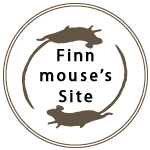Genetics
A-locus
1. Ay - Dominant Or Lethal Yellow
This is the top dominant of this series, as well as top dominant of mouse colours. Being the top dominant, no mouse can carry Ay or any of the colours with it. A mouse either has Ay, or it simply does not have it. Do note, that even if a mouse has BEW or PEW phenotype (which genotypes like Ay/* ce/ce P/* or p/p give) and a cross with a C/* mouse results in some red / fawn / similar mice, it isn't a case of the BEW/PEW mouse "carrying" Ay. The mouse still is an Ay -mouse, it still is prone to all Ay related problems and the red pigments has been simply diluted bu the c-locus reessive.
Ay removes the black pigment in the hairs of the mouse, leaving only the yellow colour. The depth of the red / yellow colour is determined by the genetic background of the mouse, i.e. what other genes the mouse has in other loci.
Red has been around literally for ages. It is one of the original colours recognized by the National Mouse Club at its formation in 1895 and there has been accounts of "yellow" mice in 80 bce Chinese annals.
In addition to affecting the colour of the mouse, Ay in one of the major obesity genes on mice. Genetically linked problems include obesity, diabetes, and increased susceptibility to tumors. Even with a restricted diet, these mice have proportionally more body fat than normal mice.
Interesting tidbit related to Ay: Ay/* s/s mice have less white than s/s mice without Ay. "A modifier of the amount of white spotting in heterozygous Kit mice was determined to reduce white spotting in heterozygous Ay mice." says MGI.
1.1. Homozygous Forms
Because Ay is a lethal gene, there are no homozygous forms of Ay. Ay/Ay young die at approximately 6 days of gestation and are reabsorbed by the mother.
All images clickable to larger size |
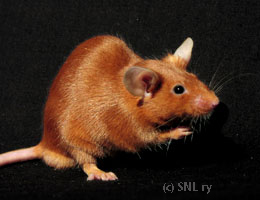
1:Red, Ay/* B/* P/* |
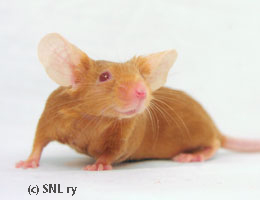
2:Fawn, Ay/* B/* p/p |
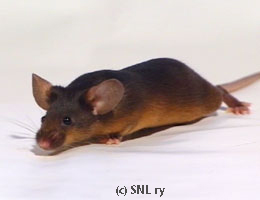
3:Sable, Ay/at B/* P/* U |
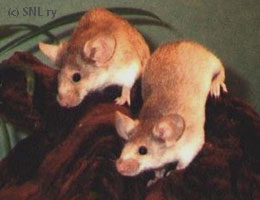
4:Marten sable, Ay/at cch/cch P/* U |
Pics by: 1-3 Arttu Väisälä, 4 Carita Tiikkainen |
1.2. Heterozygous Forms
Ay appears always in heterozygous form. Mice with Ay
a) will have 25% less babies when mated together due to the lethal factor,
b) they all are genetically prone to obesity and
c) they will not breed true.
With Ay it doesn't matter which allele of the A-series it is heterozygous with, the mouse will be of rich red to yellow colour, sometimes sooty.
Colours with Ay include: red, fawn, sable (sables), marten sable (martens), as well as straw and cream. It is also possible to get black and pink eyed white with this gene. Note, that the cream mentioned here is not the variety shown and bred in many parts of the world as cream - that variety is called bone in our standards.
Some mouse clubs have differing standards for Ay - colours, called gold, orange or yellow. These basically follow the same rules of inheritance as red.
1.2.1. Ay/Avy, Ay/Aw
None of my scientific or other written sources have indicated that Ay would be anything other than fully dominant over both the viable yellow Avy and white-bellied agouti Aw.
When the lethal yellow Ay is heterozygous with viable yellow Avy, the mice look indistinquishable from normal lethal yellow mice. Some can be rather sooty, just like the all other Ay/* heterozygous forms.
According to Tony Cooke and to all geneticist resources I'v checked, AyAw mice look like regular reds Ay/* mice.
1.2.2. Ay/A, Ay/at, Ay/a
1.2.2.1. Red and Fawn
Good show reds are Ay/A B/* (agouti background), Ay/A bc/* (cinnamon background), Ay/a B/* (black background), Ay/a bc/* (chocolate background), Ay/at B/* (black tan background) or Ay/at bc/* (chocolate tan background). All of these need the absence of the umbrous determinant (U).
Of these, the Ay/A B/* produces sometimes too sooty reds, caused by the black pigment present in the agouti - or rather, by the U present in some agouti mice. In Ay/A bc/* the sootiness is diluted by the chocolate dilution 'bc' to a lighter colour, making it "disappear" (see B-locus, bc). Ay/a B/* suffers from the same difficulties as the agouti background red, likewise does the Ay/at B/*, which is often cited as the genetic make-up of the sable mouse. However, as the proper colour on sable is made not only by U, but also groups of sable modifiers, Ay/at B/* U alone does not make a sable, but rather a sooty red, where the sootiness needs to be bred out.
It is said that the best backgrounds for good reds are the chocolate and especially the chocolate tan underdeath the red.
Fawn is the pink-eyed dilution of red, caused by the presense of p/p instead of red's P/*. This is discussed later on.
1.2.2.2. Sable
The sable mouse is one of those very, very interesting and rather difficult varieties. The basic genetic make-up of a show sable is Ay/at B/* U/*. This variety is highly dependent on so called umbrous determinants (the "U" in the genotype of a sable). The appearance of a sable is dark back, gradually shading on the sides into tan belly.
This situation is due to the mixture of hairs with dark pigment on yellow fur, with the best sables having dark, almost black sable-coloured back, shading (with the amount of dark hairs becoming fewer) over the sides. The belly has no dark hairs and is tan. The black tan often has this umbrous factor, which is why sables are produced with crossing red to black tan.
When the breeder is choosing correct shades of sable in her breeding program, she is actually working with the modifiers (in this case, the umbrous factor). The umbrous factor has been studied and it has been concluded that these determinants are either highly dominant or strongly cumulative.
If the umbrous-determinant is transferred to agouti mice, their backs are almost black, with the typical agouti colouring being found in the sides and belly only. These agoutis are sometimes seen and in judging terms they have too densely concentrated ticking on their backs. Needless to say, using agoutis with this kind of fault in agouti breeding isn't recommended at all, as they are likely to produce more of the same fault.
Umbrous agoutis can be used for breeding sable, if there aren't any (very) good black tans to work with. The resulting sables may show agouti-like "banding" on the darkest sections of their coat. On the other hand, they may also resemble your ordinary everyday sable. Interesting, isn't it?
Do note, that while the basic genotype of a sable is Ay/at B/* U/*, it is the U that makes the mouse sable instead of red, not the presence of at. sables can also very well be Ay/A B/* U/*, Ay/a B/* U/*, or Ay/ae B/* U/* and be distinquishable from Ay/at B/* U/* only by the young it produces.
There are, of course, sable dilutes like blue sable and c-locus dilutes like marten sable. However, these are discussed elsewhere.
1.2.3. Ay/ae
Scientific sources desribe Ay/ae as being a somewhat darker, deeper red mouse. Dave Bumford told me that the mouse would be sable. I would say both are right. The extreme non-agouti black mice of a fancier's stock are likely to have U, if they have ever been crossed with very well pigmented, deep black a/a black mice. Thus, when crossed with a red, there will be sable. Lab stock ae mice, on the other hand, can very well be u and give red.
Quiz Time!
Quiz 1: Why can't there be "real" red or fawn fox mice?
Answer: Because the chinchilla gene cch, which is responsible for diluting the tan belly caused by the at to turn white, will also dilute the red top colour of reds and fawns to cream.
According to Tony Cooke, AyAw mice look like regular reds, so this wouldn't lead to red foxes either. However, one can get a mouse with red pigment and fox belly with intense chinchilla ci/ci, if the red mouse "under" the c-locus recessive heterozygote has poor belly colour, which gets reduced to white or "poor fox", leaving the top apricot...
